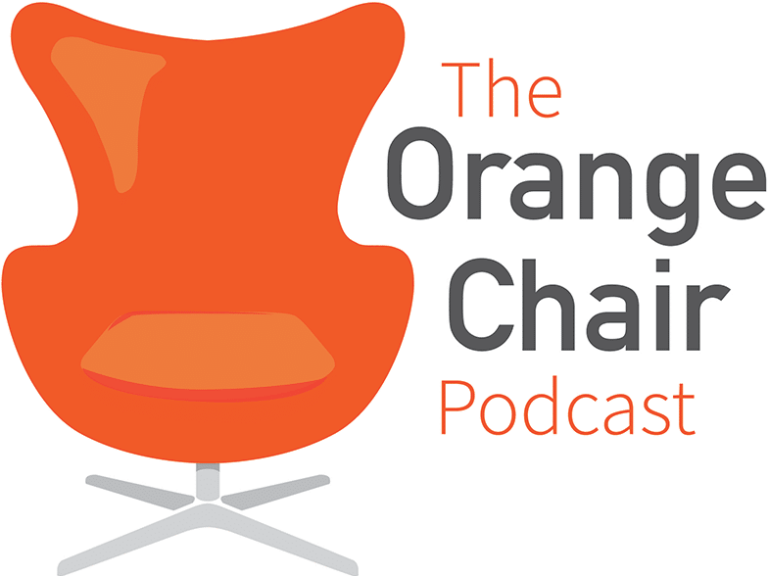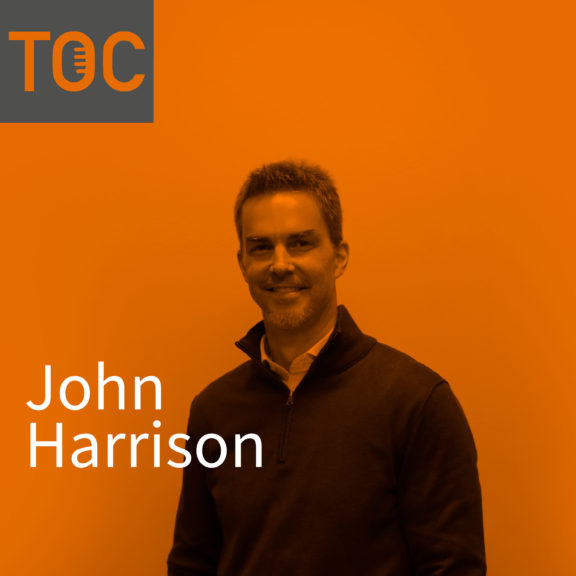This website uses cookies so that we can provide you with the best user experience possible. Cookie information is stored in your browser and performs functions such as recognising you when you return to our website and helping our team to understand which sections of the website you find most interesting and useful.
Listen now on your favorite streaming service!
presented by KeyMark


Summary
The following is a transcription from The Orange Chair Podcast. This continues our two-part “Leadership and Technology” series. Today’s episode covers topics about leadership strategies, obtaining buy-in and empowering your team. We’ll be interviewing Clemson University’s Director of Leadership Development and Corporate Relations, Gail DePriest and KeyMark’s CSO, John Harrison.
To listen to the full episode, or any other episode, you may do so by selecting your preferred podcast listening method on The Orange Chair Podcast page.
Transcription
Alex Frazier (5s): Welcome back to The Orange Chair Podcast. Today’s episode is a continuation of last week’s episode. So if you missed last, week’s make sure you go back and listen.
We have Gail DePriest in the studio from Clemson University’s MBA program and John Harrison, KeyMark’s VP of Sales, discussing leadership and technology and how the two can work together within an organization. So sit back, relax, and let’s jump on in.
Alex Frazier (38s): What do you guys see as hurdles for why business leaders may or may not be utilizing emerging technologies within their businesses? (question continued from part 1).
[The beginning of this podcast transcription has been removed due to redundancy from part 1.]
The Need for Innovative Leadership
Gail DePriest (6m 23s): I just left a luncheon with a department of commerce representative. She’s the director of innovation for the South Carolina Department of Commerce.
What she said is when she travels around the state and talks to leaders, what she hears is we need more innovative leaders.
We need more leaders who are thinking about what else can we be doing here? How else can we be creative?
Because everyone’s job is changing. Everyone’s businesses changing. I mean, the disruption is kind of out there. So getting everyone to John’s point to be thinking about “what else could we do better here?”
Whether it involves technology or whether it involves the simple things, you know, like putting in a lean process, making things work better, being more cost effective, bringing in new ideas and at least pitching them and creating cultures where people feel safe to do that.
So I loved your comments and I do think innovative leadership is going to become more and more important and people are going to need to be able to show up and speak to what that means and how they can contribute to it.
The Open Culture of Idea Sharing
John Harrison (7m 28s): Yeah. I think it’s exciting being in an environment like that here (and you, Gail, live in it every day).
To me, what that does is let’s say you are an entry level salesperson. From day one, if you’re invited to share ideas about how you can make the place better, you become a part of that family pretty quickly.
You feel like you belong regardless of what your title is or what your role is. And if you feel like that from the get go, it quickly moves away from just being a job to you thinking “I might want to make a career here and if I’m pretty good at this idea thing, then I can see a career path that would allow me to do more and have more responsibility.”
So that’s what is exciting about being here. I think any company that leads the organization that way is going to be more successful.
When you apply that to, we joke about the millennial generation, but they thrive in that environment where they think, “I’m immediately a part of what makes this organization tick.”
That that’s what I see. I mean, I think if you have the right environment there, you’re going to be very successful with people who can come in and make an immediate impact.
Gail DePriest (8m 53s): I think you all at KeyMark have a leader at the very top of the house who is an innovator. So he speaks that language all the time. I think that that definitely creates a different culture. It definitely creates a culture where everyone then feels licensed to speak that language. This is not true in every organization by any means, but it certainly does show up in the way your organization seems to operate.
The Trick to Getting Buy-In
Alex Frazier (9m 26s): Yeah. I know. I mean, just me personally from day one, it’s something as simple as having an open door policy. I think that speaks volumes and it goes a long way with every employee that “ideas are welcome here” and come with whatever you’ve got.
To shift topics for us, oftentimes buy-in is kind of the biggest hurdle when implementing a solution. We know that the solutions that we provide are great, they improve productivity, they grow businesses, they have great ROI, all of those things, but what would you guys say to that? Do you have any ideas for getting buy-in?
Gail DePriest (10m 12s): Well, I’ll take a stab at that. I really think that whenever there’s a challenge at getting in, and that certainly is the case with new technology or new ideas in general, but I think whenever you can involve people in some sort of pre-implementation. Get their ideas and their thoughts and engage them in conversation around it. Learning always goes both ways. Then they’re a little more inclined to be an advocate for whatever change that’s coming down the pipe.
I know it works that way in design thinking. When you invite a group of 30 employees in and you let them do some of the design thinking around maybe a change that needs to be made in a very large organization, they feel an ownership and they’ve had some say in what’s going on. I think that’s one way to address it.
Give All Involved Parties a Say
John Harrison (11m 5s): Yeah. I like what you just mentioned about how you get people involved. I think if you look at a team that’s making an important decision, I do think that it’s important to make sure that team is the right size. The actual, you know, three or four or five decision-makers.
If each one of those decision makers represents a certain group within the organization and they meet with their group to understand what’s important, then they’re able to take those back to the table and say “this is what’s important to our team.”
Whether it’s a technology project or whatever decision that might be, they’re able to represent the people that are going to be the most impacted by that decision.
Take KeyMark, for example. We sell business process automation software. When we look at the different parts of the organization and how they might be impacted, it’s important to understand how this is going to help them succeed and be better. We want to present that to each of the areas that will be impacted first.
I think that’s part of gaining buy-in. Let’s talk about the value that this is going to bring, and how it will help your company grow, which is going to positively impact everyone.
If we can do that, then we’re more likely to have buy-in when we come back to the table and sit down and say, this is exactly what we’re going to do.
The other part is when you get feedback, that you go back and share that with your team and say, “this is what we discussed. Here’s some of the things we’re thinking about, and these are two or three of the things that you guys shared that are going to be included in the output of whatever it is we’re doing, the solution we’re providing and implementing.”
Understanding How People Communicate
John Harrison: I’m going to throw this back to Gail. You know, we’ve done some work with Gail on how we manage our organization as a team, which is very important to moving our organization forward, continuing to grow and get better and serve our customers better.
We want to focus on how to communicate effectively, internally, so that we put the best products out for our customers.
That boils down to understanding who you’re communicating with and how they operate so that you guys can get on the same page.
I wish I could go back and apply this to my marriage because it wouldn’t have taken us in years to figure it out on our own. We’ve done alright but I think that’s very important.
If you understand how someone thinks, then you’re less likely to have them annoyed if they don’t think the way you do. You appreciate it going in. And you’re able to use that and compliment each other because you see things from a different perspective.
Gail DePriest (14m 13s): Well said. And so you wanted to throw that back to me in what way?
Understanding Team Dynamics
John Harrison (14m 21s): If you think about whether a team succeeds or doesn’t, back to the original question, I think it’s back to the approach.
If you understand who your team is and how you all fit together and what your strengths are, then you’re much more likely to be able to create a solution. Or make a decision that’s going to be positive and is going to impact your organization and in a good way. So that I hope that helps, it was a long winded answer.
Gail DePriest (15m 5s): No, it does. I’m thinking about a couple of factors in that regard. One is, is really kind of knowing who’s on your team and maybe how they need to hear the information.
I love that you said, I make a point to go back to my team and say, “here’s what was decided. Here’s what we are thinking. Here was the discussion around this.”
Because you’re in the top of the tree and you get to see these things and you talk to your team about it and understand your team. Sharing that information builds trust with them because you’re being vulnerable and saying, “we don’t have all the answers yet, but we’re putting it together and we want your input,” and so forth.
You’re building trust, but then you’re also opening the door for people to say, “well, what about this?” or “what about that?”
So if there’s any conflict or ideas that differ, people feel safe to share those with you. And usually people just want their idea to be heard, but it doesn’t have to be adopted.
Involving Your Team to Spur Buy-In
Gail DePriest: Beyond that, you’re starting to get that commitment or buy in from people at your level or at their level to where they say, “yeah, I heard about that and we know what’s happening. We know what it’s going to look like.”
Then they can actually start becoming part of the solution and the accountability for the results so they can help make it happen. So I do think there are four or five components that are engaged in addition to knowing who’s on the team. But I do think all of that sounds like what you’re doing and keeping them informed is so critical.
Never Stop Improving
John Harrison (16m 35s): Yeah. And those are all things that I think we’re striving for, but I have learned it’s just like any sport. If you practice and try to make yourself better with your mind and with what you’re trying to implement, it’s going to be just like riding a bike or dribbling a basketball or shooting. But if you don’t use it, it’s going to go away pretty quick.
I know the older you get, the quicker it goes away and the longer it takes to get it back. So, so I think what’s important is to know that, we’re always striving to get better. We’re never going to reach perfection and no matter how good things are, we have to keep trying to get better.
Alex Frazier (17m 29s): So as we wrap up our time today, do you guys have any final thoughts of anything that we’ve talked about, whether that be, a human connection versus technology or any landmines to watch out for?
Making Your Team Feel Like Important Parts of the Whole
Gail DePriest (17m 48s): I’ll go first. Okay. Well, I just, I guess I just want to respond to a couple of things that I heard from John. I know that John is Vice President of Sales here and having lived a lot of my life in sales and marketing, you said something that I think is so critical and that’s, as soon as people feel can feel connected to that ultimate purpose within the organization, then they usually feel like, “hey, I want a career here and my ideas are important here.”
The fact that you’ve got your arms around that, to me, means your salespeople will feel absolutely engaged and supported and heard. I think that’s really what empowers people to go out and sell and promote and be part of that overall mission. I think that’s mission critical. And I really applaud you for saying that.
John Harrison (18m 40s): Well, thank you. The older I get, the more I think about what’s really important.
Empower Your Team to Think Bigger about Their Future
John Harrison: Regarding one of the best managers I’ve ever had, one of the things that really stood out to me about him is I remember one of the first conversations we had was about what I wanted to do. I immediately went into, “I want to be a sales guy for this long, and I want to make this much money and I want to buy this and do this.” And he was like, “no, you’re completely missing my question. What do you want?”
And his question was really, “what do you want out of life?” Not “what do you want from this job.”
I think that’s very important. That’s one of the things we’re asking our leaders is, “do you really know your people and what they want out of life and how can KeyMark and this experience here help them get there, whether it’s with KeyMark the whole time, or whether it’s with KeyMark for five years?” Maybe the experience here catapults them to whatever it is they want.
The point being that, whether they’re here or not, if we help them get to that end game or that endpoint, then their time here is going to be really good for them and really good for KeyMark.
That came over time. That’s not, you know, that wasn’t something that, I started in 1995 and was like, “yeah, I know exactly what I want when I’m 50.”
By the way, I’m coming up on that pretty quickly.
Know Your Own Story vs. Trying to Be More Like Your Competition
Gail DePriest (20m 48s): I want to dovetail on something you just said, because I love the direction you’re going in there. There’s an author named Bernadette Jiwa. She’s out of Australia. She talks a lot about story-driven versus competition-driven. When I started reading her book, Story-Driven, it made me feel a little more free to focus on my own story.
I don’t have to compete with people on the right or the left of me. I just need to focus on my purpose and what it is I’m supposed to be contributing. I think she does a beautiful job of detailing how it’s true for individuals and it’s true for organizations.
When you get focused on your story, your purpose, your values, and what it is, who you’re serving, then you get really good at it. That’s your purpose. I remember being in sales and really, the pressure was all about competing against the other people.
But I think when you’re saying you are empowering your people, it’s asking “what’s your purpose, and what are you trying to achieve?” And “we want to help you on that journey.” That is very empowering. It takes that pressure off that old paradigm.
There used to be those companies that would line up all their people on a bell curve and rank them in the order of their top performers, which is like lining up your children and ranking them in order of how you like them. I mean, how motivating is that?
But I love the idea that we would each be empowered to think about, “what’s your story?” And, “what are your values and what do you want to contribute?”
To the point of the person who said that to you, it took a minute to get that he really cared about that. So I think it’s huge. I love that you’re onto that. I think your employees can’t help but feel appreciated and valued and they will never want to leave KeyMark.
Don’t Just Strive to Own More Things
John Harrison (22m 39s): We’re having that conversation. It’s funny, I’m having that conversation. And it was kind of a profound realization when he was like, “no, I’m not asking you what you want in terms of things.” And after we got done with our conversation, I asked him, “so what book did you recently read?”
My kids are probably tired of hearing about it, but my oldest is 22 and he’s getting ready to graduate. I’m trying to turn him on to these ways of thinking now, because I wish someone had done that for me and really said, where do you really want to be in 20 years? What does that look like? Not what do you want to have, but in life, what do you really want? Because you only get one shot.
So I’m hoping for that for folks at KeyMark. As we hire new people and we have young folks here that are incredibly bright and have a great future ahead of them, that we can help them think about those things.
I hope that it positively impacts their life beyond just what they do here at KeyMark.
Wrap-Up
Alex Frazier (24m 14s): Yeah. Well, Gail, John, thank you guys so much for being on this episode.
I think we’ve had a, a wonderful discussion and I appreciate your time. Thank you guys so much.
Gail DePriest (24m 26s): Thank you, Alex. Thank you so much for having me.
Alex Frazier (24m 38s): Well, that’s all that we have for you guys today. Thank you so much for listening to this podcast. The Orange Chair Podcast is brought to you by KeyMark.
If you liked this podcast, please leave us a rating like and subscribe to our podcast channel, wherever you guys are listening to podcasts, and you can even follow us on Instagram and Facebook. And we would love to hear from you.
This podcast is produced by Greg Aiken, Clay Tuten and me, your host, Alex Frazier. Until next time, bye guys.
Did you miss the first one? Go read Leadership and Technology, Part 1!







